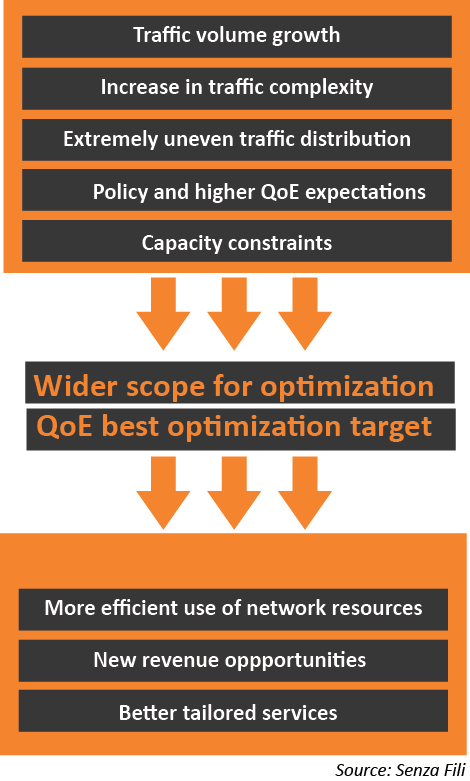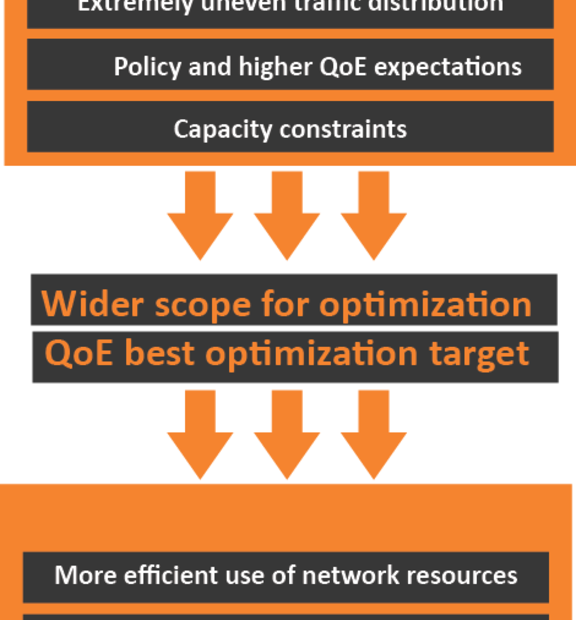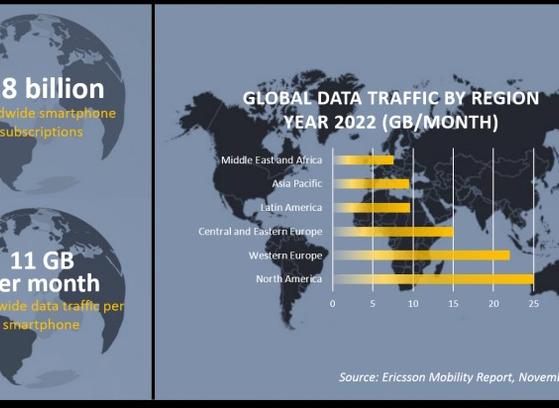The way mobile operators optimize their networks has started to change. It has to change to keep up with the growth in usage and the evolution in traffic composition, and operators are aware of the urgency of the change and are eager to embrace it. The end goal — to give subscribers the best experience allowed by the efficient use of the network infrastructure — remains the same. The way to achieve it is what is changing today.
In the legacy environment that still dominates, operators primarily maximize performance at the element level. They make sure each network element performs at its best, with performance measured by industry-accepted KPIs, on the assumption that this gives subscribers the best experience the network can support. Operators try to push as many bits as they can, as fast as they can, through their network to increase network utilization. Optimization at the network-element level maximizes throughput; hence it works in environments with homogeneous traffic composition — the type of environment mobile operators faced until recently. However, the greater volume and variability in traffic have rendered this approach inadequate in optimizing the use of network resources and expanding revenues.
The new approach to optimization no longer assumes that what is good for the network is good for subscribers. Operators first establish what the experience is like for their subscribers, and then optimize the network based on the subscriber experience. This change does not amount to swapping existing KPIs with new ones. Instead, it is a Copernican shift from a network view to a subscriber view — a shift that requires a new perspective on how to assess network performance. Successful optimization depends on the operator having an end-to-end view of the network that is tied to QoE — one that is deep enough to relate QoE measurements (and performance issues) to specific network elements, and broad enough that it sees what is happening in the core and the RAN at the same time. And this must be done in real time.
I have examined these topics in two reports I wrote recently. The first was on RAN optimization, “The smart RAN. Trends in the optimization of spectrum and network resource utilization”, and the second on core optimization, “Getting the best QoE: Trends in traffic management and mobile core optimization”. As optimization becomes and end-to-end task with its foundation in QoE driving RAN and core to converge, the two reports are complementary and examine the impact that QoE-based optimization has on how mobile operators run their networks, allocate their network resource, and try to keep their subscribers happy.
I would like to invite you to read the reports, which are available to download. They also include two insightful interviews with InfoVista. The first one, “Real-time RAN performance and QoE metrics to optimize the RAN dynamically”, was with David FitzGerald, the second, “Testing and monitoring wireless networks to capture and optimize QoE”, was with Tim Brooks.
Link to the Smart RAN
http://www.senzafiliconsulting.com/Reports/ThesmartRAN.aspx
Link to Getting the best QoE
Downloads
http://content.rcrwireless.com/SenzaFili_RAN_OptimizationReport
http://content.rcrwireless.com/Senza_Fili_QoE_Report
Link to Interviews
Additional Resources:
| Legacy: Element-based optimization | Evolution: QoE-based optimization |
| Maximize throughput, minimize latency across network and across applications | Measure and maximize QoE at the application level, using multiple data sources, such as geolocation or crowdsourcing |
| Test, monitor and optimize performance of individual network elements | Use end-to-end view of network performance to identify root causes of QoE performance issues |
| Static networks | Dynamic networks |
| RAN and core largely operate separately | Integrated RAN and core optimization |
| Historical and averaged KPIs | Real-time, location-aware and application-aware QoE data, complemented by network KPIs |












